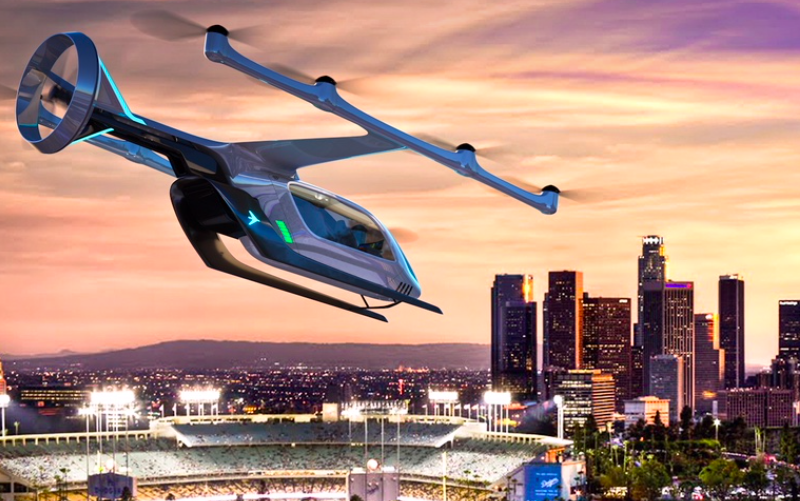eVTOLs, moats and buggy whips

Thanks to Harvard professor Theodore Levitt, many senior executives now spend a lot of time worrying about whether their companies are like 19th century buggy whip-makers. Levitt famously wrote that whip companies failed to realise that they were in the transportation business, not the buggy business, and so died.
Embraer does not want to be a buggy whip-maker and this week announced an electrical Vertical Take-Off and Landing (eVTOL) aircraft concept (pictured).
It was launched by EmbraerX, a new division of the Brazilian company: “dedicated to developing disruptive businesses that transform transportation.”
“Urban mobility is ripe for transformation and we are committed to having a major role in this key market,” said Paulo Cesar de Souza e Silva, president and CEO, of Embraer. He was speaking at a conference on eVTOL aircraft organised by Uber in Los Angeles.
Uber may seem like an unlikely aviation company. But last year it published a whitepaper called Uber Elevate arguing the economics of eVTOL taxis. The conference this week was its second in support of eVTOLS.
The company is not investing in eVTOLs or eVTOL companies (just as it does not own cars). But it is encouraging companies – including Embraer, Bell (which recently dropped the word Helicopter from its name), Aurora Flight Sciences (now part of Boeing), Slovenian manufacturer Pipistrel Aircraft, Chinese-owned Mooney Aircraft and drone-maker Karem Aircraft – to work with it on making eVTOL taxis happen.
Uber believes that flying in an eVTOL aircraft will eventually cost less than travelling by car. But for this to happen cost-effectively eVTOLs cannot be operated by pilots, so they need to be fully autonomous. Perhaps surprisingly, according to a survey of 1,500 people we conducted last month, some 13.2% of Americans say they are already prepared to fly in a pilotless aircraft.
Uber says it wants to start testing the system in 2020 with an eye to starting to carry paying passengers in 2023. Dallas Fort Worth and Los Angeles are vying to be launch cities in the US. This could change. Last year, Uber announced that it hoped to start testing in Dubai in 2020, but the UAE city has since dropped out.
The Uber Elevate project was launched before Dara Khosrowshahi became CEO of Uber and he admits he was initially sceptical about it. Levitt would approve of his change of mind. “For me the ‘aha’ moment came when I started understanding that Uber is not just about cars,” said Khosrowshahi speaking at the conference. “Ultimately, where we want to go is about urban mobility and urban transport, and being a solution for the cities in which we operate.”
Flying in 2023
Launching in 2023 may be a tad ambitious. Few industries are as highly regulated as aviation. The FAA and other authorities will – rightly – not be rushed. “I don’t think 2023 is too ambitious,” said Dan Elwell, acting administrator of the FAA, at the conference. “But I am certainly not going to make any commitments.”
Uber has famously had run-ins with many transport regulators, and won some. But these are very different when compared to dealing with federal agencies. As anyone involved in aviation knows, you do not cross an airworthiness regulator, and new air-traffic control systems and other infrastructure do not happen overnight.
While Uber deserves credit for pushing the concept, it does mean that many people now associate eVTOLs with air taxis. This is perhaps the same sort of mistake that was made when Very Light Jets were announced. The new aircraft type may eventually be operated as shared jets but the first eVTOL customers will almost certainly be individuals and corporates, who will lead the way before significant fleet buyers move in. This has been the same with the introduction of cars, aircraft and helicopters, and there is no reason why eVTOLs should be different.
At least another 20 eVTOL projects are being worked on. Some of these have raised significant amounts of investment (Larry Page, the founder of Google, owns one new entrant called Kittyhawk) but for now they are not much of a threat to existing aircraft manufacturers.
Tesla founder Elon Musk argued this week against what Warren Buffet terms moats – the competitive advantages that some companies have because of intangible and tangible assets, such as their brands or distribution networks. Musk said: “If your only defence against invading armies is a moat, you will not last long. What matters is the pace of innovation — that is the fundamental determinant of competitiveness.”
Musk and Buffet are both right.
Aircraft OEMs have strong moats – including capital, brands, production capabilities, after-service networks, supplier relationships, knowledge of the certification process and so on. So, they seem much better placed than whip manufacturers (pedants will also note that a handful of whip makers did survive). This is a huge advantage and was demonstrated 10 years ago when many new entrants tried to launch Very Light Jets. Embraer, in particular, knows this as it is one of very few new entrants to have truly succeeded in business aviation.
Moats can, however, be crossed, and not only when the defenders lower the drawbridge. As Musk says, manufacturers need to keep innovating and they are all trying. Airbus (A3 by Airbus) and Boeing (Boeing HorizonX) have similar divisions to EmbraerX.
There is even a really brilliant conference coming up in October in San Francisco called REVOLUTION.AERO focused on the companies and investors looking to disrupt business and personal aviation.
It is easy to dismiss the hype surrounding eVTOLs – especially if you are a hardened business-aviation professional with jet fuel in your blood. But they are inevitable. You may not be able to hail one on your phone come 2023, but they are coming. However, unlike a jet or helicopter you may not be able to hear them.
Subscribe to our free newsletter
For more opinions from Corporate Jet Investor, subscribe to our One Minute Week newsletter.







